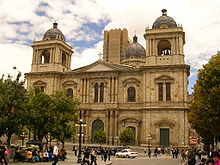Roman Catholic Church in Bolivia
The Roman Catholic Church in Bolivia is part of the worldwide Roman Catholic Church .
history
The Roman Catholic Church in Bolivia has its origins in the time of the colonization of South America , i.e. as early as the 16th century. Mainly supplied by missionaries of the Dominicans , Jesuits and Franciscans , the first diocese was founded in 1552 with the current Archdiocese of Sucre . The rapid stabilization of internal conditions led to the further establishment of the dioceses of Santa Cruz de la Sierra and La Paz in 1605.
After the colonies of South America and thus also the church there had been an appendage of Europe for centuries, it was not until the 20th century that an independent structure developed. In 1924, three more dioceses and a church province were established. In the decades that followed, the Church of Bolivia achieved its current structure.
organization
The Church in Bolivia is represented by the Bolivian Bishops' Conference , chaired by Ricardo Ernesto Centellas Guzmán , Archbishop of Sucre . The Vice-Chairman is Oscar Aparicio Céspedes , Archbishop of Cochabamba , and Aurelio Pesoa Ribera , Auxiliary Bishop of La Paz, is Secretary General .
The approximately 7.5 million Catholics of the country make up approximately 80% of the population. They live in 596 parishes , which are spread over 18 dioceses in 3 church provinces. In Bolivia there is an acute shortage of priests (as in all countries in South America): there are no more than 485 diocesan priests and 635 religious priests in the whole country. They are supported by 2,537 nuns. The religious orders (which still send missionaries) and also the diocesan priests live in poverty like the population (Bolivia is the poorest Latin American country next to Haiti and Honduras). Above all, their endeavors are aimed at the fight against poverty and the improvement of basic medical and educational services for the population.
The small number of clergymen resulted in many congregations being strongly guided and shaped by catechists. The tireless efforts of the lay helpers lead to a lively church that is present on site and does not wait for a “service from afar”.
Increasing anti-church aggression
In 2009 the Catholic aid organization “Kirche in Not” reported on increasing attacks by groups close to the government on Catholic communities. A clergyman had been forced to sign a permit to demolish a chapel and community buildings financed by German donations had been destroyed. Bolivia's current Prime Minister Evo Morales is quoted as saying that the Church is an "enemy of peace" and must be replaced. The head of the Latin America department of the aid agency, Javier Legorreta, warns that the Bolivian Catholic Church will become "a persecuted church [...], a suffering church in great need".
List of dioceses by ecclesiastical province
- Archdiocese of Cochabamba : Diocese of Oruro , Territorial Prelature Aiquile
- Archdiocese of La Paz : Diocese of Coroico , Diocese of El Alto , Territorial Prelature Corocoro
- Archdiocese of Santa Cruz de la Sierra : Diocese of San Ignacio de Velasco
- Archdiocese of Sucre : Diocese of Potosí , Diocese of Tarija
- Immediate: Military Ordinary , Apostolic Vicariate Camiri , Apostolic Vicariate El Beni o Beni , Apostolic Vicariate Ñuflo de Chávez , Apostolic Vicariate Pando , Apostolic Vicariate Reyes
Some important people in the Bolivian Church
- St. Nazaria Ignacia March Mesa (1889–1943), founder of the order, canonized on October 14, 2018 by Pope Francis.
- Cardinal Julio Terrazas Sandoval CSSR, (1936–2015), Archbishop of Santa Cruz de la Sierra
- Cardinal Josef Clemens Maurer CSSR, (1900–1990), Archbishop of Sucre and first Cardinal of Bolivia
- Cardinal Toribio Ticona Porco (* 1937), first indigenous cardinal of the country, emeritus prelate of the territorial prelature Corocoro .
- Jorge Manrique Hurtado (1911–1995), Archbishop of La Paz
- Edmundo Abastoflor Montero (* 1943), Archbishop of La Paz
- P. Luis Espinal SJ, (1932–1980), left-wing intellectual and martyr of persecution during the military dictatorships
- Bonifaz Madersbacher OFM, (1919–2007), mission bishop in the diocese of San Ignacio de Velasco
Directory of nuncios since 1979
Diplomatic relations between the Holy See and Bolivia have existed since the mid-19th century. The nunciature is in La Paz.
- Alfio Rapisarda , 1979-1985
- Santos Abril y Castelló , 1985-1989
- Giovanni Tonucci , 1989-1996
- Rino Passigato , 1996-1999
- Józef Wesołowski , 1999 - 2002
- Ivo Scapolo , 2002 - 2008
- Luciano Suriani , 2008
- Giambattista Diquattro , 2008 - 2017
- Angelo Accattino , since 2017
literature
- Stefan Silber : Catholicism, cultures, indigenous theology. An overview of mission theological developments in Bolivia, in: Neue Zeitschrift für Missionswissenschaft 60 (2004) 1, 21–49
- Stefan Silber: Bolivien, in: Erwin Gatz (Ed.): Church and Catholicism since 1945, Vol. 6: Latin America and the Caribbean. Edited by Johannes Meier and Veit Straßner, Paderborn, Munich, Vienna, Zurich: Ferdinand Schöningh 2009, 365–380
Individual evidence
- ↑ Archived copy ( Memento from November 25, 2015 in the Internet Archive ) (Spanish)
- ↑ Country report Bolivia July 2009
- ↑ Press release of May 26th, 2009 from "Church in Need"


